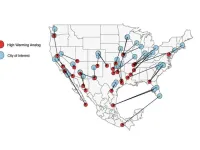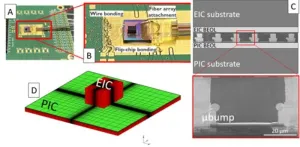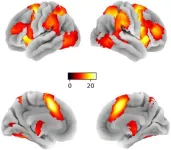(Press-News.org) Human noroviruses cause acute gastroenteritis, a global health problem for which there are no vaccines or antiviral drugs. Although most healthy patients recover completely from the infection, norovirus can be life-threatening in infants, the elderly and people with underlying diseases. Estimates indicate that human noroviruses cause approximately 684 million illnesses and 212,000 deaths annually.
“Human noroviruses are highly diverse,” said first author Dr. Wilhelm Salmen, a graduate student in Dr. B V Venkataram Prasad’s lab while he was working on this project and currently a postdoctoral fellow at the University of Michigan. “Noroviruses are categorized into10 groups, of which groups GI, GII, GIV, GVIII and GIX infect humans. Viruses in the GII.4 subgroup are the most predominant in human populations.”
Noroviruses also are notorious for periodically giving rise to new variants, particularly those of GII.4 norovirus, that can evade the immune response the body has developed against previous variants, like some flu viruses and coronaviruses do. The diversity of norovirus groups and the recurring emergence of new variants are some of the factors challenging the development of effective preventive and therapeutic approaches to control this serious disease.
In the current study published in the journal Nature Communications, Salmen, Prasad and their colleagues investigated a novel strategy to neutralize human noroviruses. They tested whether tiny antibodies produced by llamas, called nanobodies, could effectively neutralize human norovirus infection in the lab. The unexpected findings reveal that nanobodies could be developed as a therapeutic agent against human norovirus.
Llama nanobodies may give an upper hand
Llamas and related animals such as camels and alpacas, produce antibodies for protection against disease just like people do. However, compared to people’s antibodies, llama’s are about a tenth of the size of human antibodies. Llama’s nanobodies have been developed against viruses such as those causing hepatitis B, influenza, human immunodeficiency, polio and other diseases.
“Our collaborators from Argentina, Dr. Marina Bok and Dr. Viviana Parreño at the Institute of Virology and Technology Innovation, had prepared nanobodies from llamas that were inoculated with human norovirus-like particles from different strains,” Salmen said. “We worked with one nanobody named M4, which bound to the predominant GII.4 strain, testing its ability to neutralize different norovirus strains, that is, to prevent them from infecting human cells.”
The researchers tested the ability of the nanobodies to prevent live viruses from infecting human intestinal organoids or mini guts grown in the lab. Mini guts are models of human intestinal cells, closely representing actual small intestine tissue and its functions, that enable scientists to study how noroviruses work and to test potential therapies.
“It was really unexpected to see that the M4 nanobody not only interacted and neutralized the currently circulating pandemic GII.4 strain but also its older variants,” said Prasad, Alvin Romansky Chair in Biochemistry and professor in the Verna and Marrs McLean Department of Biochemistry and Molecular Pharmacology and the Department of Molecular Virology and Microbiology at Baylor. He also is a member of Baylor’s Dan L Duncan Comprehensive Cancer Center and corresponding author of the work.
The researchers used crystallography and other techniques to look closely at the interactions between nanobodies and noroviruses to try to understand how the M4 nanobody recognizes and neutralizes a variety of noroviruses when they expected it would recognize only the GII.4 strain used to generate M4.
“We discovered that this little nanobody can recognize a part of the norovirus that all the different noroviruses that we tested have in common,” Salmen said.
The team discovered that the M4 nanobody recognized a hidden pocket in the norovirus particles that would be exposed only when the particles underwent a structural change. “The traditional thinking is that viral particles are in a very stable compact state, but in reality these particles ‘breathe’ considerably,” Salmen said. “Recent studies have shown that the structure of norovirus particles is dynamic, alternating between a resting or compact conformation and a raised conformation.”
“We think that the raised state is important for the virus to bind to cells and infect them,” Prasad said. “We also think that when the viral particles are in the raised state, the hidden pocket is exposed and available for the nanobody to bind to it and, acting like a wedge, to keep the particle in an elevated, potentially unstable state, preventing it from collapsing back down into the compact, more stable resting state.”
“Our findings suggest that trapping the viral particles in an elevated, unstable state disassembles the particles, which kills the virus. This effectively would stop the infection as it blocks the transmission chain, preventing the virus from spreading from cell to cell,” Salmen said.
“This study is also remarkable in confirming that the human norovirus must change its 3D confirmation, from compact to raised, to infect people,” said co-author Dr. Mary Estes, Distinguished Service Professor of Virology and Microbiology and Cullen Foundation Endowed Chair at Baylor. She also is a member of Baylor’s Dan L Duncan Comprehensive Cancer Center. “Also, this work reveals the importance of considering viral particle dynamics when designing vaccines.”
Other contributors to this work include Liya Hu, Natthawan Chaimongkol, Khalil Ettayebi, Stanislav V. Sosnovtsev, Kaundal Soni, B. Vijayalakshmi Ayyar, Sreejesh Shanker, Frederick H. Neill, Banumathi Sankaran, Robert L. Atmar and Kim Y. Green. The authors are affiliated with one of the following institutions: Baylor College of Medicine, Institute for Virology and Technology Innovation-Argentina, National Institutes of Health and Lawrence Berkeley Laboratory.
This study was supported in part by the National Institutes of Health grants P30 GM124169-01, P30 CA125123 and P01 AI057788, and a grant from the Robert Welch Foundation (Q1279). Further support was provided by a Fulbright Program grant and by the Division of Intramural Research, NIAID, NIH.
###
END
Llama power: Tiny llama nanobodies neutralize different noroviruses. Can they improve human anti-viral therapies?
2023-12-07
ELSE PRESS RELEASES FROM THIS DATE:
Less ice on the road leads to more salt in the soil, air, and water
2023-12-07
When temperatures drop and roads get slick, rock salt is an important safety precaution used by individuals, businesses, and local and state governments to keep walkers, cyclists, and drivers safe. However, according to a new scientific review paper from a team of researchers at Virginia Tech and the University of Maryland, the human demand for salt comes at a cost to the environment.
Published in the journal Nature Reviews Earth & Environment with researchers Stanley Grant, Megan Rippy, and Shantanu Bhide from Virginia Tech’s Occoquan Watershed Monitoring Laboratory, ...
Very early treatment of newborns with HIV could result in medication-free remission for many babies
2023-12-07
An unexpectedly high percentage of children, who were born with HIV and started treatment within 48 hours of life, exhibit biomarkers by 2 years of age that may make them eligible to test for medication-free remission, according to a multinational study published in Lancet HIV.
“Moving away from reliance on daily antiretroviral therapy (ART) to control HIV would be a huge improvement to the quality of life of these children,” said Protocol Co-Chair and senior author Ellen Chadwick, MD, former Director of Section ...
Sister climate cities, utility data predict future water, electricity demands
2023-12-07
UNIVERSITY PARK, Pa. – Modern-day Ciudad Mante, Mexico, could help Tampa, Florida, plan for shifting water and electricity demands due to climate change, according to an international team of researchers. Led by Renee Obringer, assistant professor of energy and mineral engineering at Penn State, the researchers used utilities data and climate analogs — contemporary cities with climates close to what other cities are predicted to experience in the future — to assess how climate change may impact residential water and electricity use across 46 cities in the United States.
Their computationally efficient model projected strong regional differences for future water and electricity ...
New target found for treatment of spinal muscular atrophy
2023-12-07
The lab of Yongchao C. Ma, PhD, at Stanley Manne Children’s Research Institute at Ann & Robert H. Lurie Children’s Hospital of Chicago uncovered a novel mechanism that leads to motor neuron degeneration in spinal muscular atrophy (SMA). This discovery offers a new target for treatment that overcomes important limitations of gene therapy and other current therapies for SMA.
SMA is a genetic disease that disrupts the nerve cells that control voluntary muscle movement. Symptoms of motor neuron degeneration could start at as early as 3 months of ...
Mass General Cancer Center researchers present key findings at American Society of Hematology (ASH) Meeting
2023-12-07
Investigators from the Mass General Cancer Center, a part of the Mass General Brigham healthcare system, will present research discoveries and outcomes from clinical trials at the 2023 American Society of Hematology (ASH) Annual Meeting, held December 9-12, 2023 in San Diego.
ASH brings together leading experts in classical and malignant blood diseases to share the latest breakthroughs, clinical studies and research impacting the field and patient care. Mass General Cancer Center researchers will cover a wide range of topics, including ...
Thermal impact of 3D stacking photonic and electronic chips
2023-12-07
Recent advancements in AI and more specifically large language models such as ChatGPT have put a strain on data centers. AI models require huge amounts of data to train, and in order to move data between the processing units and memory, efficient communication links become necessary. For long distance communication, fiber optics has already been the go-to solution for decades. For short distance intra-data center communication, the industry is now also starting to adopt fiber optics due to its great performance compared to classical electrical links. Recent technological developments now even enable the switch from electrical to optical interconnect for very small distances, ...
Protein found in brain linked to frontotemporal dementia
2023-12-07
INDIANAPOLIS—An international team of researchers including experts at the Indiana University School of Medicine has identified a protein found in the brains of people with frontotemporal dementia (FTD), discovering a new target for potential treatments for the disease.
According to the National Institutes of Health, FTD results from damage to neurons in the frontal and temporal lobes of the brain. People with this type of dementia typically present symptoms, including unusual behaviors, emotional problems, trouble communicating, difficulty with work or in some cases difficulty with walking, ...
CU's CellSight contributes light-sensitive retinal organoids and RPE cells to new AMD study
2023-12-07
A partnership between ophthalmology researchers at the University of Colorado School of Medicine and Johns Hopkins University expands the understanding of how oxidative stress contributes to the development of choroidal neovascularization (CNV) in patients with age-related macular degeneration (AMD).
To study the roles oxidative stress, a condition in which the body lacks antioxidants, and hypoxia play in the progression of AMD, Johns Hopkins University researchers turned to CellSight, the ocular stem cell and regeneration research program in the CU Department of Ophthalmology, for tools that allow researchers to explore specific conditions ...
Novel stem cell therapy using technology from mRNA COVID-19 vaccines may stimulate natural repair in treatment of chronic and acute liver disease
2023-12-07
BOSTON – Mortality related to end stage liver disease is ranked as the 12th most common cause of death in the U.S. Liver transplantation remains the only treatment for end stage liver disease, but there is a critical shortage of organ donors, necessitating a dire need for new forms of treatment.
New research from Boston Medical Center and Boston University Chobanian & Avedisian School of Medicine’s Center for Regenerative Medicine (CReM) found evidence that a novel stem cell treatment, using mRNA technology encapsulated into nanoparticles (LNP) that was ...
Unlocking brain secrets: New insights into how our minds control impulses
2023-12-07
Published in the 2023 Volume 3 issue of Psychoradiology a team of dedicated researchers from The University of Hong Kong and The University of Electronic Science and Technology of China has conclusively identified the right inferior frontal gyrus (rIFG) as a key input and causal regulator within the subcortical response inhibition nodes. This right-lateralized inhibitory control circuit, characterized by its significant intrinsic connectivity, highlights the crucial role of the rIFG in orchestrating top-down cortical-subcortical control, underscoring the intricate dynamics of brain function in response inhibition.
In ...



